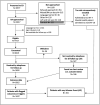How safe are paediatric emergency departments? A national prospective cohort study
- PMID: 35853646
- PMCID: PMC9606537
- DOI: 10.1136/bmjqs-2021-014608
How safe are paediatric emergency departments? A national prospective cohort study
Abstract
Background: Despite the high number of children treated in emergency departments, patient safety risks in this setting are not well quantified. Our objective was to estimate the risk and type of adverse events, as well as their preventability and severity, for children treated in a paediatric emergency department.
Methods: Our prospective, multicentre cohort study enrolled children presenting for care during one of 168 8-hour study shifts across nine paediatric emergency departments. Our primary outcome was an adverse event within 21 days of enrolment which was related to care provided at the enrolment visit. We identified 'flagged outcomes' (such as hospital visits, worsening symptoms) through structured telephone interviews with patients and families over the 21 days following enrolment. We screened admitted patients' health records with a validated trigger tool. For patients with flags or triggers, three reviewers independently determined whether an adverse event occurred.
Results: We enrolled 6376 children; 6015 (94%) had follow-up data. Enrolled children had a median age of 4.3 years (IQR 1.6-9.8 years). One hundred and seventy-nine children (3.0%, 95% CI 2.6% to 3.5%) had at least one adverse event. There were 187 adverse events in total; 143 (76.5%, 95% CI 68.9% to 82.7%) were deemed preventable. Management (n=98, 52.4%) and diagnostic issues (n=36, 19.3%) were the most common types of adverse events. Seventy-nine (42.2%) events resulted in a return emergency department visit; 24 (12.8%) resulted in hospital admission; and 3 (1.6%) resulted in transfer to a critical care unit.
Conclusion: In this large-scale study, 1 in 33 children treated in a paediatric emergency department experienced an adverse event related to the care they received there. The majority of events were preventable; most were related to management and diagnostic issues. Specific patient populations were at higher risk of adverse events. We identify opportunities for improvement in care.
Keywords: adverse events, epidemiology and detection; emergency department; paediatrics.
© Author(s) (or their employer(s)) 2022. Re-use permitted under CC BY-NC. No commercial re-use. See rights and permissions. Published by BMJ.
Conflict of interest statement
Competing interests: LAC is the CEO of the Canadian Medical Protective Association and chair of the Saegis Board of Directors (paid positions). KC is the chair of Acute Care Committee, Canadian Paediatric Society, and the past president of the Section for Emergency Medicine, Canadian Paediatric Society (unpaid positions). GY is a voting member of the Royal College Committee for Pediatric Emergency Medicine (Canada) (unpaid). ASN is the secretary-treasurer for the Mental Health Executive, Canadian Paediatric Society (unpaid).
Figures
Comment in
-
Why identifying adverse events in paediatric emergency care matters.BMJ Qual Saf. 2022 Oct 19;31(11):776-778. doi: 10.1136/bmjqs-2022-014939. BMJ Qual Saf. 2022. PMID: 35863876 Free PMC article. No abstract available.
References
-
- Secondary Care Analytic Teams NHS Digital . Hospital accident and emergency activity 2019-20. Available: https://digital.nhs.uk/data-and-information/publications/statistical/hos... [Accessed 7 Dec 2021].
-
- Sun R, Karaca Z, Wong HS. Trends in Hospital Emergency Department Visits by Age and Payer, 2006–2015: Statistical Brief #238. Healthcare Cost and Utilization Project (HCUP) Statistical Briefs. Rockville, MD: Agency for Healthcare Research and Quality, 2006. - PubMed
Publication types
MeSH terms
LinkOut - more resources
Full Text Sources
Medical

